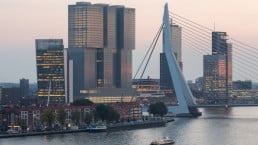
Rotterdam, Holland’s large port city, is in many ways Amsterdam’s polar opposite, and is often overshadowed by the capital city’s picturesque 17th century charm. Many parts of Rotterdam, including its 17th century harbour and inner city, were bombed during WWII, resulting in most of the classic Dutch Golden Age architecture being replaced with unpretentious modern apartment blocks and high-rises during post-war reconstruction. Today, the bold, cubed architecture gives the city a striking skyline. Even Amsterdammers, who used to turn up their nose notoriously at their rival city, have started to move to Rotterdam in recent years because it has more space and fewer tourists. With exciting architecture and a constantly evolving art and design scene, Rotterdam boasts its very own flavour of charm, especially through its locals, who are exceptionally warm for a big cosmopolitan city. The first few months of the year are always busy in Rotterdam in terms of arts and culture: January and February are packed with the international art fair Art Rotterdam, Rotterdam Photo, design fair Object Rotterdam, and the world-renowned IFFR (International Film Festival Rotterdam). Museumnacht (Night of the Museums), when museums and galleries in Rotterdam open to the public at night, takes place in March. Summer in Rotterdam is equally packed with cultural events, for example with the Poetry International Festival in June and the internationally acclaimed North Sea Jazz Festival in July. We take a look at some of these cultural events while sharing our favourite Rotterdam gems and making sure you don’t miss the finest spots in the city for discovering art, regardless of the time of the year.
Art Rotterdam and IFFR
The usual Art Rotterdam in February this year was the best edition yet, showcasing 90 Dutch and international galleries with a strong focus on strengthening ties between the Dutch and international art scene. As always, the art fair was held at the former cigarette factory and UNESCO World Heritage Site Van Nellefabriek. Prospects & Concepts, a section of the fair organised by the Mondrian Fund, featured the youngest generation of promising artists, such as Rabi Koria, Katerina Konarovská and Golrokh Nafisi.
Meanwhile at IFFR, the best of international contemporary film was on offer, while its excellent side-programs showcased contemporary art institutions in Rotterdam. Blackout Installations at De Kunsthal, for example, revolved around the carousel slide projector and its role in the process of remembering, while Witte de With Centre for Contemporary Art co-produced Beirut-based Lawrence Abu Hamdan’s performance After SFX, in which he investigates auditory memory using sounds, voices and texts from Earwitness Inventory, his personal library of sound effects.

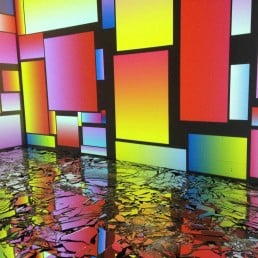
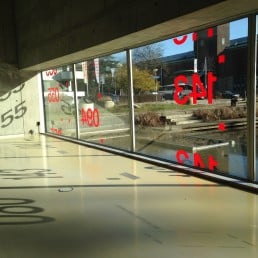
Museumpark
There are still plenty of art events to enjoy and look forward to in Rotterdam this spring. First off, the city is paying homage to the centenary of Bauhaus with its exhibition ‘Netherlands Bauhaus – pioneers of a new world’ at the Boijmans van Beuningen Museum, running till 26 May 2019. This is the last exhibition at Boijmans before the large-scale renovation of the museum commences, whereupon which the museum will close for about four years. The ‘Netherlands Bauhaus’ exhibition explores works by Bauhaus artists like Paul Klee, Wassily Kandinsky, László Moholy-Nagy and Oscar Schlemmer, as well as by Dutch pioneers including Mart Stam, Paul Citroen, J.J.P. Oud, Theo van Doesburg, Gerrit Rietveld and Piet Zwart, who have had an unmistakable influence on the Bauhaus movement. The exhibition shows 800 objects, from paintings to furniture, ceramics, textile, photographs, typography and architecture. Concurrent to this exhibition is ‘When the Shutters Close,’ an exhibition showing the highlights of the Boijmans van Beuningen collection. Other highlights include Yayoi Kusama’s famous ‘Infinity Mirror Room – Phalli’s Field,’ which the Boijmans purchased from Kusama in 2010, and Pipilotti Rist’s video installation ‘Let Your Hair Down.’
Right next to the Boijmans is the Boijmans van Beuningen Depot, a circular building, which is slated for public opening in 2021. The Depot will be the first museum depot in the world to offer access to a complete collection without the intervention of a conservator. The public will have the unique opportunity to wander around the 151,000 art objects stored in the depot and look in on conservation and restoration practices. What’s more, the Depot is an architecture icon in the making, as the cylindrical building, designed by architect Winy Maas from MVRDV, will be covered in mirrors on all sides while a rooftop garden brings life to the top of the building.
Boijmans van Beuningen is located in the city centre’s Museumpark, where you will also find De Kunsthal and Het Nieuwe Instituut. Het Nieuwe Instituut, an institution for architecture, design and digital culture, is right across from the Boijmans van Beuningen. Its rotating exhibitions examine how the world is changing due to new technologies, new ways of thinking and shifting social priorities. Expect the most cutting-edge in contemporary digital culture, design and architecture here. Recent highlights include ‘Work, Body, Leisure,’ the Dutch contribution to the Biënnale Architettura 2018, and Prix de Rome Architecture 2018, which presents the four nominees who have each created a fascinating solution for the ‘forgotten’ Sixhaven area in Amsterdam-North (both exhibitions run till 10 March 2019).
Designed by one of Rotterdam’s most famous exports Rem Koolhaas, De Kunsthal is a museum without a permanent collection, offering regularly changing exhibitions with crossovers between different art disciplines. Currently on view through 25 May 2019 is ‘Trouble in Paradise,’ showcasing the collection of Rattan Chadha divided into his three collecting themes: Soul Searching, Delicious Confusion and Forever Young. Chadha’s daring and provocative pieces range from Marlene Dumas to Candice Breitz, Marc Bijl and Rafaël Rozendaal. Also on show is ‘Picasso on Paper,’ which delves into Picasso’s late works, namely his sketches and etchings – through 12 May 2019.
If you’re looking for interesting design shops not far from the Museumpark, the Nieuwe Binnenweg is a good place to start. Take a load off with some delicious coffee and food at Lilith or Urban Espresso Bar on the same street. Alternatively, check out the shops on Mathenesserlaan, another hotspot for contemporary design — particularly for furniture.
End your day with some arthouse cinema or old classics at Kino, just off the Nieuwe Binnenweg and around the corner from the Museumpark.
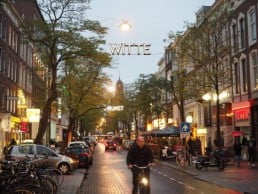
Witte de With Quarter
Not far from the Museumpark is the Witte de With Quarter, centred around the Witte de Withstraat, a street overflowing with galleries, design stores, bars and restaurants. Unquestionably, the first stop here is the Witte de With Centre for Contemporary Art, which was founded in 1990. Witte de With remains at the forefront of important contemporary social debates, working with artists who pose challenging questions and broach complex topics. Sharing the building with Witte de With is TENT, a platform for contemporary art from Rotterdam which occupies the ground floor.
Several exhibitions are currently on show at Witte de With: On Contemporary Arab Representations, a long-term project developed from 2002-2003 by the then director of Witte de With, offers locally-specific cultural representations of Beirut, Cairo and Iraq. An exhibition with an audio script by Sarah Demeuse and Wendy Tronrud, as well as a soundtrack by Mario Garciá Torres in collaboration with Sol Oosel explores the phenomenon of ‘dropping out’ through a series of engaging personal stories told by female artists and cultural workers who in one way or another ‘dropped out’ from the art world. The exhibition raises the question: ‘What distinguishes dropping out from being or feeling pushed out, or burning out?’ Firelei Baéz, new work includes three paintings and an immersive installation, drawing from her research on the Haitian Revolution. Finally, Lawrence Abu Hamdan, a solo exhibition explores the political implications of listening through the world of the ear-witness. Among other projects, the artist investigated the Syrian regime prison Saydnaya through ear-witnesses, which he presents in his film Walled Unwalled (2018).
A stone’s throw from the Witte de With is MAMA, a vibrant platform for contemporary visual culture and young talent at the cutting edge of contemporary art and popular culture. MAMA programs exhibitions in its own space, but also far beyond the confines of its walls in other spaces in the city. Its program is filled with educational events, cultural events and research projects which engage audiences through visual arts and culture. Current exhibition Apa kabar? (What’s new?), running until 26 May 2019, explores the relationship and the tensions between mainstream online culture and specific local settings and contexts.
On the Eendrachtsstraat 57A, a beautiful street branching off from the Witte de Withstraat, is the home of art collector Julian Oggel. Here, you can visit his eclectic art collection, the Concordia Collection, which he has been amassing since 2002 (appointments can be made by e-mail only: julian.oggel@xs4all.nl). His collection retains strong ties to Rotterdam due to the presence of local artists like Ron van der Ende and Marin de Jong, and of international artists like Keith Haring and Ivan Chermayeff who produced art while staying in Rotterdam. Oggel’s main passion is collecting Pop Art, but he also owns Hyperrealist and Conceptual artworks.
Another Rotterdam collection well worth a visit is the Alexander Ramselaar Collection. Ramselaar specialises in contemporary art and presents his collection in the living room, bedrooms, stairwell, and even bathroom of his Rotterdam townhouse. An avid traveller, Ramselaar started out collecting art by Rotterdam artists, and now collects international artists as well. Artists in his collection include Yael Bartana, Hans Op de Beeck, Guy Tillim, and Rossella Biscotti. Visits are permitted only occasionally and inquiries must be made via e-mail: art@alexander-ramselaar.com.
Take a break from all the artistic input at Rotterdam’s beloved bar De Witte Aap, also on Witte de Withstraat, with a great selection of beers and typical Dutch beer snacks. Another nearby treasure is Wunderbar/Worm on Boomgaardsstraat. This quirky bar boasts delicious drinks, vegetarian meals and all kinds of performances and parties. And if it’s great design shops you’re looking for, look no further — the Witte de Withstraat is filled with them, from furniture to clothing stores.
An absolute must when in Rotterdam, just a ten-minute bike-ride from the Witte de Withstraat, is the Markthal. This is Rotterdam’s answer to a covered marketplace with countless stalls selling a huge variety of international cuisine, baked goods and fruit and vegetables. The Markthal also houses an incredible Asian supermarket where you can find practically any spices and ingredients you may be looking for.
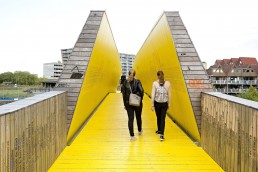
Provenierswijk
North of Rotterdam Central Station is Provenierswijk, a neighbourhood which has remained largely intact after the WWII bombings, and, with its 1920s-30s architecture, is considered one of the most charming parts of the city. A great way to get from the central district of the city to Provenierswijk in the north is by the Luchtsingel, a 390 metres-long bridge modelled after New York’s High Line and accessible from nine entry points. Right next to the Provenierswijk exit from the bridge is Bird, Rotterdam’s answer to a jazz club-meets-restaurant that also branches into soul, funk, hiphop and electronic music.
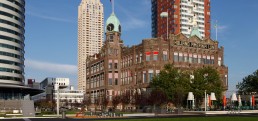
Kop van Zuid
The redeveloped docklands area Kop van Zuid is located on the south bank of the Nieuwe Maas river, and is connected to the centre of town by the Erasmus Bridge. Kop van Zuid is home to cultural institutions like the Dutch Photography Museum. If you’re into cutting-edge contemporary architecture and design, book a room at nHow Rotterdam, the hotel designed by Rem Koolhaas and located in his bold building project De Rotterdam. With in-house exhibitions, amazing views and a rooftop terrace overlooking Rotterdam’s skyline, a stay at nHow is an amazing way to experience the city. Rooms start around €100 per night.
For a trip back in time, stay the night and dine at Hotel New York, a hotel in the former office building of the Holland America Lines, built in 1901. This is where European émigrés would pass through on their way to start a new life in America in the 19th and early 20th century. Room prices start at €100 per night for a double room. While there, enjoy a meal at Hotel New York’s grand café-restaurant or indulge in cocktails and culinary delights in the style of pre-war Manhattan at Hotel New York’s NY Basement.
Local tip: if you’re planning to visit many museums it pays off to buy a Museumcard, a membership card which offers free entry to over 400 museums in the Netherlands. The card costs €64,90, and for people who don’t reside in the Netherlands, the card is valid for 31 days, and will get you into five museums of choice for free. Since most museum entry fees in the Netherlands are between €15 and €20 these days, it’s definitely worth it if you want to visit more than three museums.